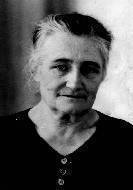| Note* | She Religion: ev Occupation: Housewife grandfather, George Jacob married on 28 January 1913 Simmern / Hunsrück our grandmother Charlotte lever. She was a sixth cousin Grades of the famous poet Johann Peter Hebel. It was on 15 August 1888 as the oldest of four children of the wool spinners and hospital attendant Johann Peter Hebel and his wife Margaret Menk from Riesweiler in Altweidelbach born. She died on March 23, 1963 and was buried on Mar 26, 1963 in Simmern / Hunsrück. She was baptized a Protestant and tried a godly life to lead. She was a housewife and still earned a church newspaper unsubscribe add something for a living. Saturday afternoon, they heard the bells on the radio people, which was at that time ever broadcast from a different church in the Hunsrück. For them it was a devotion which it has enjoyed with eyes closed, and we children would have never dared to interfere in this effort. I still remember that both Grandpa and Grandma used to rest after lunch about 30 minutes. In the kitchen of her grandparents, there were two wooden chairs. These were curved and provided with a backrest. (So-called Thonet chair). Grandpa's kitchen chair stood at the left side of the kitchen stove and grandma on the right side between stove, firewood box and sink. Both were able to immediately close your eyes, and were gone. After exactly 30 minutes they were again woke up and did their daily work continues.'s Grandparents lived in an old barracks in the Koblenz Road 45 in Simmern. The barracks was built 1832nd The ground floor was the restaurant to the city of Koblenz. While there was a restaurant next to the entrance, but was rarely used by the tenants. The barracks had been built in a rocky slope in. (The rock was built for off blown up.) For bakers Göttel next door (sweet fragrance is always looking for fresh baked goods) was a very steep path up with carved intermediates the slope and into a right turn behind the barracks manufactured and landed behind a meadow, the then at what was then exit at ground level around the Koblenz Street got along. I think they were called the grandson Wies. In Bauer Kuhn at the exit. (The gentle slope of the Koblenzstrasse was here in the slope between the bakery and barracks in a few meters taken steep advance.) Between the road and the building was a two to three meter wide moat, which is about five levels, ie 80-10 meters deep. There was the back door that led through a narrow bridge to the path. On the back door there was also one of the very few toilets (outhouse) that were grown out of. This was almost always occupied, and of course the last user had to clean it. The consequences of this was that all the male inhabitants of the house the rock wall that loomed beyond the steep path abused as a urinal. When I poem by Hans Joachim Ringelnatz read was once late, "beloved wall that I wetting often ...." Failed me again and again rock wall it in and the penetrating odor rose back to me in the nose. Aunt Elsie, daughter of the grandparents, a war widow lived with her son, Hans Werner with the household of the grandparents. But she had a room on the same floor with separate entrance. Aunt Elsie earned her living as Weisnäherin. That is, they went to mend Simmerner heeled families, and sew. If a shirt collar was worn, it was from the back of the shirt cut out a piece for the collar and replaced it with another substance remains. From the piece so cut a new collar was sewn. Saturday afternoon was bathed with Grandma. You have to understand that the house still belonged to a large room that was lit but only through a window to the kitchen and ventilated. I even think that the window was painted white so that you could not see inside. The room was only used as a junk room and the room was also a zinc bath where the bath has been enjoyed on Saturdays. Lucky the one who was allowed to take the first bath. The rest of the family used the same water that was warmed up at most times with the hot water boiler from the heat. At least there were 3-4 people who used the same water. For poor people that was in the 50gern still quite common. The water was then used for watering plants or it was the laundry is soaked. Unforgotten cakes are grandmothers. There was not a Sunday without cake. Crumb cake with very thick crumbs. However, fruit cakes, cheesecakes or marble cake of grandma are forgotten. Several decades later, I visited my cousin Helga. When I tasted the cake, I was immediately reminded of grandma's cake. Prepares Helga but the cake but just like our grandmother and it tastes just as delicious. It was Sunday with his grandparents always a large coffee table. Uncle and Aunt Gretel hubby with my cousins and Helga Gisela. Aunt Elsie and their son Hans Werner were always there anyway. In addition there were grandmas sisters, aunt and aunt Liesche Katsche as well as their relatives from Kirchberg. When Grandma was always a meeting place for the family. The rest of cake usually held until Wednesday before and tasted it still. It used to be so that one has enjoyed so-called the twilight. Family life was played out in the kitchen. A living room had not even the grandparents. The lights stayed out for as long as possible and the furnace respectively. Herdklappe would open. This gave the whole room with a homey atmosphere. We children sat and listened to Grandma feet the stories of the past. joined in the Christmas season, there were still to apples, the scent of my nose before. in 2010. |












